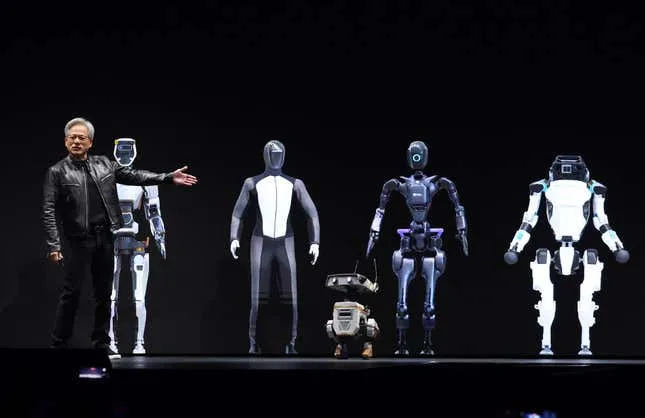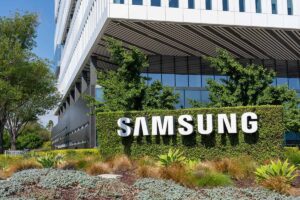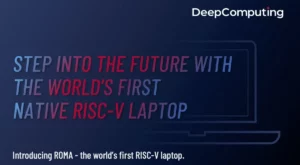
Introduction
Artificial intelligence (AI) has seen phenomenal growth in recent years. But what’s next on the horizon for this field? According to Jensen Huang, CEO of tech giant NVIDIA, the future of AI lies not just in the digital realm, but in the physical world – and it’s being driven by robots.
- Humanoid robots can thrive in our world: Unlike robots designed for specific tasks, humanoid robots can function in the world that’s already built for humans. This is because they have a similar physical form to us, and there’s a vast amount of data available to train them since they interact with the same environment we do.
- Self-driving cars are poised for high volume: Huang believes self-driving cars are another area where AI-powered robotics will see significant growth. This technology has the potential to revolutionize transportation and become extremely widespread.
Overall, Jensen Huang sees robotics as a natural progression of AI. Nvidia is investing in robotics not just through developing its own technology but also by funding robotics startups like Figure AI.
The Issac Platform
NVIDIA, under Huang’s leadership, has made significant strides in developing AI technologies that power autonomous machines. Industry leaders are actively adopting the company’s Isaac robotics platform to develop AI-powered autonomous machines.
The Isaac platform features a collection of accelerated libraries and AI models that facilitate the development of advanced robotics capabilities. These tools enable robots to perform complex tasks with greater efficiency and precision. For example, the Isaac ROS is a set of modular ROS(Robot Operating System) 2 packages that bring NVIDIA acceleration to the robotics community.
A key component of the Isaac platform is its simulation technologies, particularly the Isaac Sim, which is a reference application for simulating, testing, and validating robots in physically based environments. This allows for the generation of synthetic data and the fine-tuning of AI models in a controlled virtual space, based on the NVIDIA Omniverse platform.
Companies like BYD Electronics, Siemens, Teradyne Robotics, and Intrinsic (an Alphabet company) are integrating Isaac into their frameworks to enhance their operations.
Over 100 companies are adopting Isaac Sim to simulate, test, and validate robotic applications. This includes prominent names like Hexagon, Husqvarna Group, and MathWorks. Additionally, humanoid robot developers such as Agility Robotics, Boston Dynamics, Figure AI, Fourier Intelligence, and Sanctuary AI are adopting Isaac Lab for AI robot foundation model training.
Jensen Huang Vision: Project GR00T
NVIDIA’s Project GR00T, stands for Generalist Robot 00 Technology. It is a groundbreaking initiative that aims to create a general-purpose foundation model for humanoid robots. This new model empowers robots to understand natural language and mimic human movements by observing our actions.
As part of Project GR00T, NVIDIA has introduced Jetson Thor, a new computing platform specifically designed for humanoid robots. This platform is based on the NVIDIA Thor system-on-a-chip (SoC) and is optimized for performance, power, and size. It includes a next-generation GPU with a transformer engine capable of delivering 800 teraflops of 8-bit floating point AI performance. It is essential for running multimodal generative AI models like GR00T.
Why Jensen Huang, CEO of Nvidia, is heavily invested in the future of robots:
The Rise of “Physical AI”:
Huang argues that the next wave of AI is “physical AI” – AI that can operate in the real world and understand the laws of physics. This is a significant shift from AI models that primarily exist in the digital realm.
Huang envisions a future filled with robots seamlessly integrated into various industries, from manufacturing to healthcare. These robots won’t be confined to pre-programmed tasks but will be able to adapt and learn in real-time.
Nvidia’s Strategic Advantage:
Nvidia’s core strength lies in its graphics processing units (GPUs) which are particularly adept at handling complex AI computations. This processing power is crucial for training the sophisticated algorithms needed for robots to navigate the physical world.
By focusing on robotics, Nvidia hopes to expand its market beyond just the gaming and computer graphics industries where it currently dominates. Robotics represents a vast and untapped potential for growth. [2]
The Two Big Bets:
Huang sees significant potential in humanoid robots that can operate alongside humans. These robots wouldn’t necessarily replace humans but could collaborate with us in various tasks. He believes the existing human-centric infrastructure makes this a logical step.
Self-driving cars are another area where Huang sees massive growth potential. Widespread adoption of autonomous vehicles would require significant advancements in AI and robotics, which aligns perfectly with Nvidia’s expertise.
Beyond Hardware:
While Nvidia is a leader in hardware for AI, Huang recognizes the importance of a robust software ecosystem for robots to thrive. This is where Nvidia’s Omniverse platform comes in – a virtual world specifically designed for simulating and developing AI for robotics applications.
Overall Vision:
Jensen Huang’s vision is for Nvidia to be at the forefront of this “physical AI” revolution. By providing the hardware and software foundation for robots, Nvidia hopes to not only be a key player but also shape the entire robotics landscape of the future.
Conclusion
Jensen Huang’s belief in robots and self-driving cars as the leading forces in AI’s next phase is rapidly becoming a reality. With NVIDIA’s cutting-edge technologies and the industry’s adoption of these advancements, we are stepping into a future where autonomous machines are an integral part of our lives.







